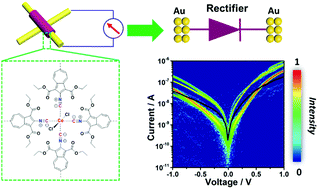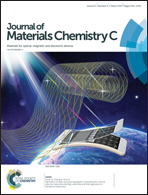Azulene-bridged coordinated framework based quasi-molecular rectifier†
Abstract
Although many molecular-level diodes have exhibited proof-of-concept rectification effect, realization of practical molecular rectifiers still remains a challenge because of unstable and sensitive molecular layers, complicated fabrication methods and not easily accessible measurement techniques. Thus, development of robust and easy procedures for molecular diodes with stable rectification effect is the top priority for the community in this field. Herein, we report a new home-made quasi-molecular rectifier based on a coordinated framework thin film prepared by a layer-by-layer dip-coating method. The as-fabricated rectifier exhibits an average rectification ratio as high as 5.7 and excellent cycle stability over 300 cycles, rendering it a very promising candidate for practical application in comparison with previously reported molecular rectifiers. Besides, such a diode fabrication process can be easily achieved without the aid of expensive scanning tunneling microscopes, precise electrodes approaching operations at an Ångström scale, and other complex techniques. All these results not only demonstrate coordinated frameworks could be good candidates for molecular rectifiers, but also provide a new strategy for fabrication of home-made molecular rectifiers without employing complicated procedures and expensive equipment.



 Please wait while we load your content...
Please wait while we load your content...